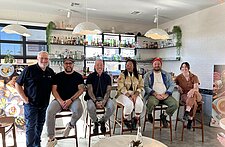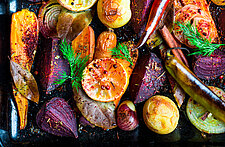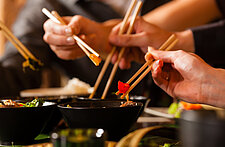In an interview with Chef Alejandro Morgan, Emmanuel Laroche, Symrise’s Vice President, Marketing & Consumer Insights, Global Marketing Leader, discussed how the Chef’s Costa Rican background influenced his menus at his San Francisco restaurants. Chef Morgan is the Executive Chef at Lolinda (lolindasf.com), the Argentinean inspired steakhouse. In his rooftop restaurant, Chef Morgan and his staff offer Costa Rican favorites and popular choices from other Latin American countries – all with a modern flair, but deliciously authentic.
What type of ingredients or dishes have you seen trickling down to restaurants that began as foods that cooks were preparing for themselves?
The use of Aji Amarillo peppers and yucca from Peru are good examples. Many ingredients that combine very well with other food – the use of masa, for instance, the corn flour called masa harina that is used to make tamales and tortillas. The technique used in preparing chimichurri has had its influence and can become even more influential.
Is there a Costa Rican equivalent to carimañola, a fried yucca roll? It appears in Panama, Colombia and as a street food in Miami where it’s known as Yucca Croquetta.
Yes, but it’s called something entirely different in Costa Rica. Enjucada. You make a similar paste of boiled yucca that is folded into a safrita with meat stuffing. We serve it in a croquette form. There are many other similarities of food that is served in different parts of Latin America where they go by different names.
Are there examples of street foods that you have observed in Latino neighborhoods in San Francisco?
There are many street foods that you can find in the Mission district. Our rooftop restaurant captures the items sold as street foods – we serve bocas, chorreadas, chucos on skewers, we do corn with cheese and empanadas.
What new Latino trends are you seeing in foods, ingredients and flavors?
In the past two years, we have seen a lot of Peruvian cooking and it continues to gain in popularity. Peruvian restaurants are appearing all over – especially in New York, Miami and here. There are Peruvian style peppers (Aji Amarillo and Rocoto), now available in the U.S., and there is a Peruvian corn that’s beginning to be seen here as well as Asian/Hispanic fusion empanadas. In the past three years, a lot of empanada restaurants have been showing up in the city – Chilean, Argentinean, Venezuelan places. They are making different versions, updating old recipes.
From your own experience, what is the biggest misconception that people have about Latino cuisine?
People believe that Latino food means spicy food but not in areas where there is a dense
concentration of Latino people. Spicy foods are found in Mexico and Peru for the most part. I lived in Mississippi for a short time and people thought I would add hot ingredients to the foods I ate but I really didn’t. Also, there’s the notion that our food is cheap and heavy. I think that’s because people became acquainted with Latino food through chains where the food was loaded with beans and cheese – not even Latin American varieties. That’s what the heart of America associates with Latino foods. They don’t realize how light and rich it is. I don’t think this association is true for those living in major U.S. cities, but in other places, it’s all about tacos and burritos. Authentic Latin American food is much lighter than people think.
Follow Lolinda on Twitter: @LolindaSF
Check back next week on in-sight for part 3 of Emmanuel's interview with Chef Morgan!




